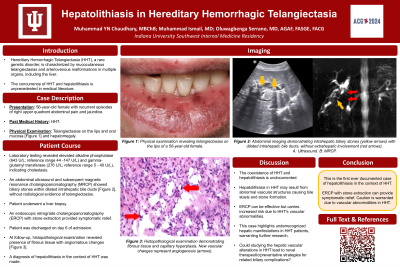Tuesday Poster Session
Category: Liver
P4839 - Hepatolithiasis in Hereditary Hemorrhagic Telangiectasia: A Case Report
Tuesday, October 29, 2024
10:30 AM - 4:00 PM ET
Location: Exhibit Hall E

Has Audio

Muhammad YN Chaudhary, MBChB
Indiana University Southwest
Evansville, IN
Presenting Author(s)
Muhammad YN. Chaudhary, MBChB1, Muhammad Ismail, MD2, Oluwagbenga Serrano, MD, FACG3
1Indiana University Southwest, Evansville, IN; 2Indiana University Southwest, Cedar Rapids, IA; 3Good Samaritan Hospital, Vincennes, IN
Introduction: Hereditary Hemorrhagic Telangiectasia (HHT), also known as Rendu-Osler-Weber syndrome, is a rare genetic disorder characterized by mucocutaneous telangiectasias and arteriovenous malformations (AVMs) in multiple organs, including the liver. Hepatolithiasis is typically associated with conditions like recurrent cholangitis or biliary tract anomalies. The co-occurrence of HHT and hepatolithiasis is unprecedented in medical literature, presenting a unique diagnostic and therapeutic challenge. This case highlights the clinical complexity and expands the understanding of hepatic manifestations in HHT.
Case Description/Methods: A 56-year-old male with HHT presented with recurrent episodes of right upper quadrant abdominal pain and jaundice. Physical examination revealed telangiectasias on the lips and oral mucosa, and hepatomegaly. Laboratory tests showed elevated alkaline phosphatase (643 U/L) and gamma-glutamyl transferase (276 U/L), indicating cholestasis.
Abdominal ultrasound and magnetic resonance cholangiopancreatography (MRCP) revealed multiple intrahepatic biliary stones within the dilated intrahepatic bile ducts. There were no signs of common bile duct stones or extrahepatic biliary obstruction. Given the patient's history and imaging findings, a diagnosis of hepatolithiasis in the context of HHT was considered.
A liver biopsy was performed, showing intrahepatic bile ducts with luminal calculi and fibrosis. Immunohistochemical staining demonstrated dilated vascular channels consistent with HHT. The patient underwent endoscopic retrograde cholangiopancreatography (ERCP) with stone extraction, providing symptomatic relief.
Discussion: The coexistence of HHT and hepatolithiasis is rare. Hepatolithiasis in HHT may result from abnormal vascular structures causing bile stasis and stone formation. This case highlights the need for vigilance for hepatobiliary complications in HHT patients.
Recognizing this association is crucial for physicians as it affects diagnosis and management. Standard treatments like ERCP and biliary drainage can be effective but must be approached cautiously due to HHT's vascular abnormalities. Regular monitoring and early intervention are essential to prevent recurrent cholangitis and secondary biliary cirrhosis. Further research into hepatic manifestations of HHT is needed to improve patient management.
This case adds to the limited literature on HHT's hepatic complications, offering insights for future clinical practice and research.
Disclosures:
Muhammad YN. Chaudhary, MBChB1, Muhammad Ismail, MD2, Oluwagbenga Serrano, MD, FACG3. P4839 - Hepatolithiasis in Hereditary Hemorrhagic Telangiectasia: A Case Report, ACG 2024 Annual Scientific Meeting Abstracts. Philadelphia, PA: American College of Gastroenterology.
1Indiana University Southwest, Evansville, IN; 2Indiana University Southwest, Cedar Rapids, IA; 3Good Samaritan Hospital, Vincennes, IN
Introduction: Hereditary Hemorrhagic Telangiectasia (HHT), also known as Rendu-Osler-Weber syndrome, is a rare genetic disorder characterized by mucocutaneous telangiectasias and arteriovenous malformations (AVMs) in multiple organs, including the liver. Hepatolithiasis is typically associated with conditions like recurrent cholangitis or biliary tract anomalies. The co-occurrence of HHT and hepatolithiasis is unprecedented in medical literature, presenting a unique diagnostic and therapeutic challenge. This case highlights the clinical complexity and expands the understanding of hepatic manifestations in HHT.
Case Description/Methods: A 56-year-old male with HHT presented with recurrent episodes of right upper quadrant abdominal pain and jaundice. Physical examination revealed telangiectasias on the lips and oral mucosa, and hepatomegaly. Laboratory tests showed elevated alkaline phosphatase (643 U/L) and gamma-glutamyl transferase (276 U/L), indicating cholestasis.
Abdominal ultrasound and magnetic resonance cholangiopancreatography (MRCP) revealed multiple intrahepatic biliary stones within the dilated intrahepatic bile ducts. There were no signs of common bile duct stones or extrahepatic biliary obstruction. Given the patient's history and imaging findings, a diagnosis of hepatolithiasis in the context of HHT was considered.
A liver biopsy was performed, showing intrahepatic bile ducts with luminal calculi and fibrosis. Immunohistochemical staining demonstrated dilated vascular channels consistent with HHT. The patient underwent endoscopic retrograde cholangiopancreatography (ERCP) with stone extraction, providing symptomatic relief.
Discussion: The coexistence of HHT and hepatolithiasis is rare. Hepatolithiasis in HHT may result from abnormal vascular structures causing bile stasis and stone formation. This case highlights the need for vigilance for hepatobiliary complications in HHT patients.
Recognizing this association is crucial for physicians as it affects diagnosis and management. Standard treatments like ERCP and biliary drainage can be effective but must be approached cautiously due to HHT's vascular abnormalities. Regular monitoring and early intervention are essential to prevent recurrent cholangitis and secondary biliary cirrhosis. Further research into hepatic manifestations of HHT is needed to improve patient management.
This case adds to the limited literature on HHT's hepatic complications, offering insights for future clinical practice and research.
Disclosures:
Muhammad Chaudhary indicated no relevant financial relationships.
Muhammad Ismail indicated no relevant financial relationships.
Oluwagbenga Serrano: MERCK – Stock-publicly held company(excluding mutual/index funds).
Muhammad YN. Chaudhary, MBChB1, Muhammad Ismail, MD2, Oluwagbenga Serrano, MD, FACG3. P4839 - Hepatolithiasis in Hereditary Hemorrhagic Telangiectasia: A Case Report, ACG 2024 Annual Scientific Meeting Abstracts. Philadelphia, PA: American College of Gastroenterology.
